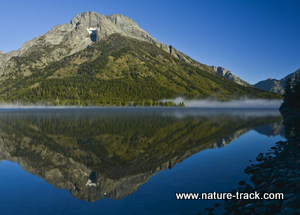Mount Moran Geology

Mount Moran is like an awesome history book if you know how to read it.
Mount Moran reflected perfectly in the still waters of Leigh Lake in Grand Teton National Park. From the canoe it seemed that we could almost touch the rugged cliffs and read the long history of the mountain in the surface of the water.
The geologic record of the Tetons is well chronicled in Mount Moran. From the top of the summit to its base, it reads like a book, although there are pages that may seem out of order.
The story of Mount Moran starts long before there was even a hint of mountain. Two and a half billion years ago, the entire area was deep under a vast deep sea. Starting with sand and volcanic ash, sediments were deposited to incredible depths over millions of years. Heat and pressure metamorphosed the bottom sediments into gneiss, the hard weather resistant rock that forms the backbone of the Teton Range.
We could clearly see a black vertical line slicing down from the top of the mountain. This 150 foot wide black dike, made of diabase rock, was injected as igneous or molten rock into cracks in the gneiss while still a part of the seafloor. This same process created the other igneous rock in abundance in the Teton Range: granite.
Seventy million years ago, when the Farallon Tectonic Plate collided with the North American Plate, the earth’s crust buckled and crumpled forming the Rocky Mountains. But the Teton Range, while no longer part of a sea, remained a vast plain for another 60 million years.
It was a stretching continent that finally triggered the Teton fault to shift. In the first episode, the west side of the fault jumped upward perhaps ten feet while the east or valley side dropped three to four times that much. Mount Moran and its sister peaks were born and continued to grow each time the tension was released through a violent earthquake. As the mountains rose, the thick layers of sediment eroded down into the valleys until the underlying gneiss and granite remained.
From the lake, one of the most telling pages in the geologic book was hidden from view. The cap of Mount Moran is Flathead sandstone, a sedimentary deposit found 24,000 feet below the valley floor below. Each shift of the fault separated the pieces of the layer a little more. The offset between the mountain range rising and the valley floor dropping was a whopping 30,000 feet. That the difference of peak to valley is currently only 6000-7000 feet is telling: the steady forces of nature including erosion, volcanic ash and glaciation all filled in the valley.
From the glacially created Leigh Lake, we could easily see the Falling Ice Glacier, one of five glaciers on the mountain. These are tiny reminders of what was once a powerful force in shaping the mountain and surrounding areas. Glaciation occurred three times, starting about 150,000 years ago with an ice pack up to 2000 feet thick.
In Mount Moran is the story of the creation of the youngest mountain range in the Rocky Mountain chain. It is also a story whose ending has not been written because although we can’t see them, these processes continue today.

"WOW. What a phenomenal piece you wrote. You are amazing." Jennifer Jackson
That is embarrassing, but actually a fairly typical response to my nature essays. Since The Best of Nature is created from the very best of 16 years of these nature essays published weekly in the Idaho Falls Post Register (online readership 70,000), it is a fine read. It covers a wide variety of topics including humorous glimpses of nature, philosophy, natural history, and conservation. Readers praise the style, breadth of subject matter and my ability to communicate complex and emotional topics in a relaxed and understandable manner.
Everyone can find something to love in this book. From teenagers to octogenarians, from the coffee shop to the school room, these nature essays are widely read and enjoyed.
Some of the essays here are my personal favorites, others seemed to strike a chord with readers. Most have an important message or lesson that will resonate with you. They are written with a goal to simultaneously entertain and educate about the wonderful workings of nature. Some will make you laugh out loud and others will bring a tear to the eye and warm your heart.
Readers Write:
"You hit a home run with your article on, Big Questions in Nature. It should be required reading for everyone who has lost touch with nature...great job!" Joe Chapman
"We enjoyed your column, Bloom Where Planted. Some of the best writing yet. The Post Register is fortunate to have your weekly columns." Lou Griffin.
To read more and to order a copy, click here or get the Kindle version
Copies are also available at:
Post Register
Island Park Builders Supply (upstairs)
Barnes and Noble in Idaho Falls
Harriman State Park, Island Park
Museum of Idaho
Valley Books, Jackson Wyoming
Avocet Corner Bookstore, Bear River National Wildlife Refuge, Brigham City, Utah
Craters of the Moon National Monument Bookstore, Arco, Idaho